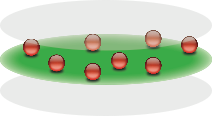Ultracold Few-body Physics

Below, you will find a brief description of some aspects of my research, as well as links to a more details description. Some selected publications are also highlighted.

Selected Publications ...
-
“Origin of the three-body parameter universality in Efimov physics”, Jia Wang, J. P. D’Incao,
-
B. D. Esry, and Chris H. Greene, Phys. Rev. Lett. 108, 263001 (2012)
-
“Universal three-body parameter in heteronuclear atomic systems”, Yujun Wang, Jia Wang,
-
J. P. D’Incao and C. H. Greene, Phys. Rev. Lett. 109, 243201 (2012)
-
“Signatures of four-body universal phenomena and their relation to the Efimov effect”,
-
von Stecher, J. P. D'Incao, and C. H. Greene, Nature Physics 5, 417 (2009)
-
“Evidence of universal four-body states tied to an Efimov trimer”, F. Ferlaino, S. Knoop,
-
M. Berninger, W. Harm, J. P. D’Incao, H.-C. Naegerl, R. Grimm, Phys. Rev. Lett 102,
-
“Universal four-boson states in ultracold molecular gases: Resonant effects in
-
dimer-dimer collisions”, J. P. D’Incao, J. von Stecher and Chris H. Greene, Phys. Rev.

Selected Publications ...
-
“Scattering length scaling laws for ultracold three-body collisions", J. P. D'Incao and
-
B. D. Esry, Phys. Rev. Lett. 94, 213201 (2005).
-
“Mass dependence of ultracold three-body collision rates", J. P. D'Incao and B. D. Esry,
-
“Ultracold few-body systems”, Y. Wang, J. P. D’Incao and B. D. Esry,
-
Advances of Atomic, Molecular and Optical Physics 62, 1 (2013)
-
“Ultracold three-body collisions near narrow Feshbach resonances”, Yujun Wang, J. P.
-
D'Incao, and B. D. Esry, Phys. Rev. A 83, 042710 (2011)
-
“Dimer-Dimer collisions at finite energies in two-component Fermi gases”, J. P.
-
D'Incao, Seth Rittenhouse, N. P. Mehta, and Chris H. Greene, Phys. Rev. A 79,
-
“Suppression of molecular decay in ultracold gases without Fermi statistics”,
-
J. P. D'Incao and B. D. Esry, Phys. Rev. Lett. 100, 163201 (2008)

Selected Publications ...
-
-
“Universal three-body physics for fermionic dipoles”, Y. Wang, Jose P. D’Incao,
-
and Chris H. Greene, Phys. Rev. Lett. 107, 233201 (2011)
-
“Efimov effect for three interacting bosonic dipoles”, Y. Wang, J. P. D’Incao,
-
and C. H. Greene, Phys. Rev. Lett. 106, 233201 (2011)
-
“Collisional aspects of bosonic and fermionic dipoles in quasi-two-dimensional confining
-
geometries”, J. P. D’Incao and C. H. Greene, Phys. Rev. A 83, 030702 (R) (2011)

Selected Publications ...
-
“Cold three-body collisions in Hydrogen-Alkali atomic systems”, Y. Wang,
-
J. P. D'Incao and B. D. Esry, Phys. Rev. A 83, 032703 (2011)
-
“Magnetically Controlled Exchange Process in an Ultracold Atom-Dimer Mixture”,
-
S. Knoop, F. Ferlaino, M. Berninger, M. Mark, H.-C. Naegerl, R. Grimm, J. P. D’Incao
-
and B. D. Esry, Phys. Rev. Lett. 104, 053201 (2010)
-
“Ultracold three-body collisions near overlapping Feshbach resonances”, J. P. D’Incao
-
and B. D. Esry, Phys. Rev. Lett. 103, 083202 (2009)
-
“Universal four-boson states in ultracold molecular gases: Resonant effects in
-
dimer-dimer collisions”, J. P. D’Incao, J. von Stecher and Chris H. Greene, Phys. Rev.
-
“Stability of fermionic Feshbach molecules ”, J. J. Zirbel, K.-K. Ni, S. Ospelkaus, J. P.
-
D'Incao, C.E. Wieman, J. Ye, and D. S. Jin, Phys. Rev. Lett. 100, 143201 (2008)

Selected Publications ...
“Ultracold Three-body Recombination in Two Dimensions”, J. P. D’Incao,
Fatima Anis and B. D. Esry, submitted to Phys. Rev. A [arXiv:1411.2321]
“Adiabatic Hyperspherical Representation for the Three-body Problem in Two Dimensions”,
J. P. D’Incao and B. D. Esry, Phys. Rev. A 90, 042707 (2014)
-
“Collisional aspects of bosonic and fermionic dipoles in quasi-two-dimensional confining
-
geometries”, J. P. D’Incao and C. H. Greene, Phys. Rev. A 83, 030702 (R) (2011)







[Home] [Research] [Publications] [People] [Research Highlights] [Links]
[Home] [Research] [Publications] [People] [Research Highlights] [Links]






